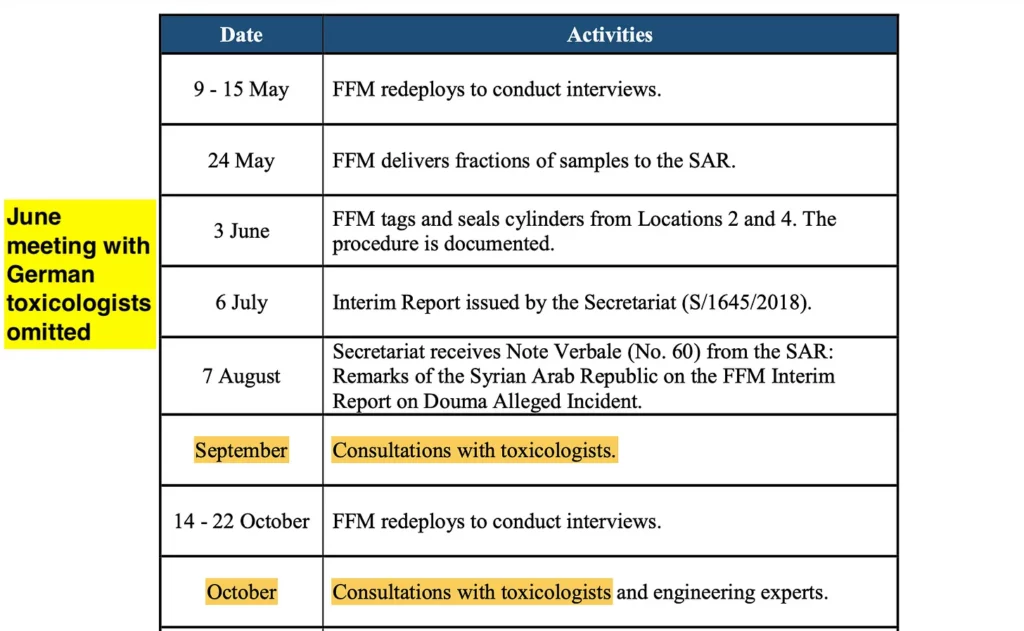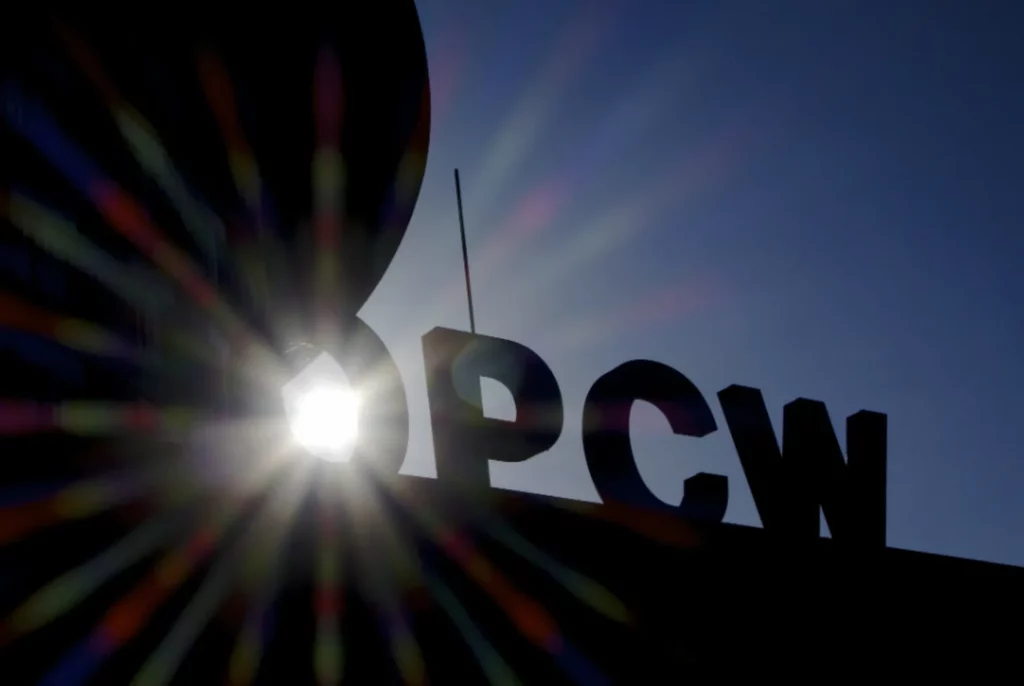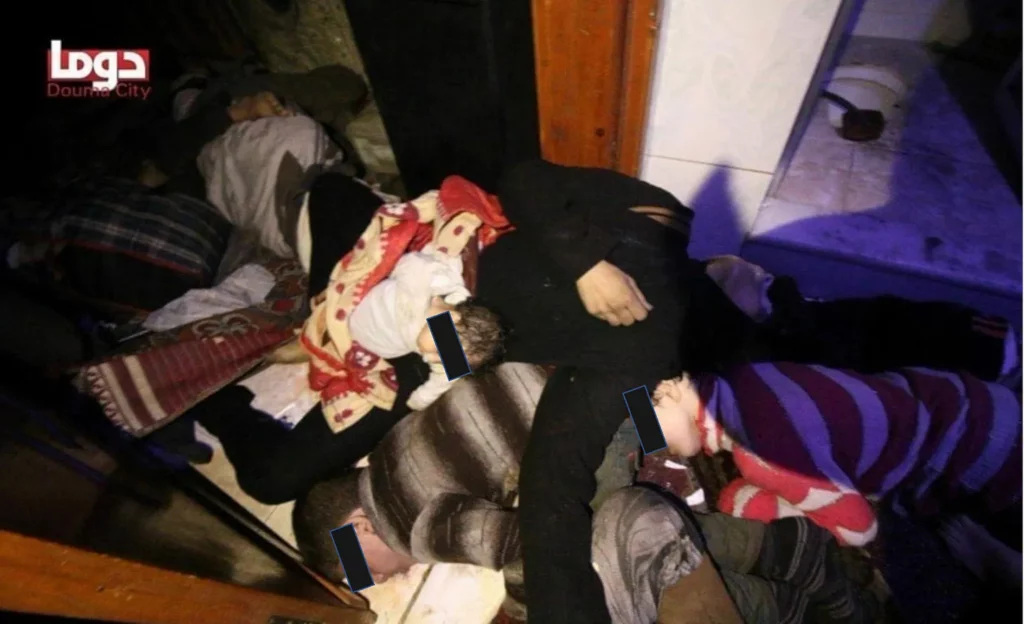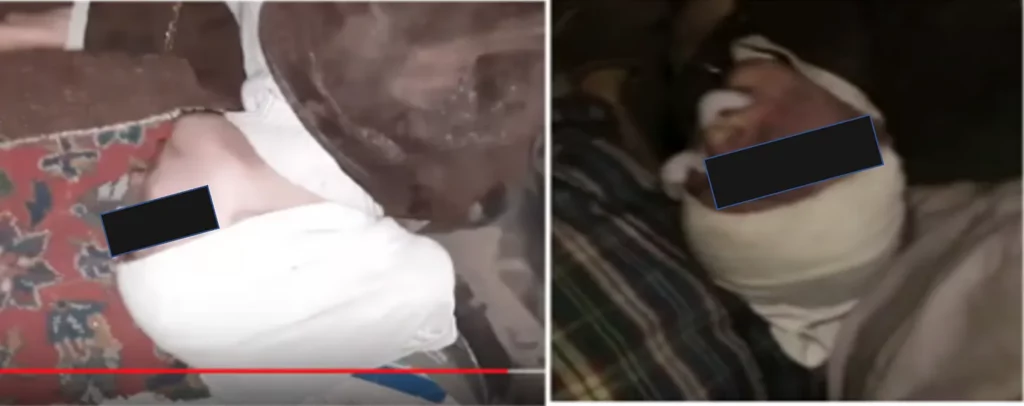Burying Key Evidence, New OPCW Report Covers up Douma’s Unsolved Deaths
SYRIA IN CONTEXT, 3 Apr 2023
Aaron Maté | Substack – TRANSCEND Media Service
After censoring experts who found that the victims in Douma could not have been killed by chlorine gas, the Organisation for the Prohibition of Chemical Weapons’ new IIT report continues the cover-up and baselessly accuses the Syrian government.
[Note: this article contains graphic images.]
27 Mar 2023 – On April 7th 2018, gruesome images of an alleged chemical attack emerged from the Syrian town of Douma.
Dozens of dead bodies, including children and infants, appeared heaped in piles inside of an apartment building. Others lay on the street in front as if trying to escape deadly gas. Strikingly, many of the victims displayed copious foam oozing from the mouth and nose. Along with their proximity to a clear escape route, these visible symptoms suggested that something extraordinarily poisonous had killed them instantly.
US officials immediately promoted the allegations of insurgent-tied groups that the Syrian army had killed the victimswith chlorine gas or the nerve agent sarin, or even a combination of both. One week later, the US, along with the UK and France, bombed Syria in purported retaliation.
In public statements, however, experts raised doubts that chlorine caused the deaths in Douma. Leaked documents later revealed that German military toxicologists consulted by the Organisation for the Prohibition of Chemical Weapons (OPCW) in June 2018 went further. The Germans told the OPCW that the circumstances of the fatalities – apparent immediate death and collapse in piles at the center of two rooms, a failure to escape, and rapid profuse foaming at the mouth and nose – were inconsistent with chlorine poisoning.
The Germans’ findings had profound ramifications. While the Douma victims’ signs of rapid foaming were not consistent with exposure to chlorine gas, they were consistent with nerve agent exposure. But by that point, the OPCW’s chemical analysis had ruled out sarin or any other nerve agent as the killer because none of these chemicals were found at the scene or in biomedical samples from alleged victims.
If the rapid and profuse frothing was not the result of a nerve agent or chlorine poisoning, the possibility existed that there was no chemical attack at all – and that insurgents staged the incident to frame the Syrian government. The OPCW would be dealing with a faked chemical attack that triggered US-led airstrikes on Syria, and the unexplained deaths of 43 men, women, and children.
As I have reported, the OPCW censored the German toxicologists’ input in a cover-up of findings that undermined allegations of a Syrian army chemical attack in Douma. More than three years since that suppression was exposed, the OPCW has never offered a rebuttal to the initial toxicology assessment, nor an explanation for why it was concealed. They have simply buried it.
In a new report on Douma released in January, the OPCW finally purports to offer a counter-narrative. The OPCW’s Investigation and Identification Team (IIT) claims that the “symptoms of the victims” in Douma “are, overall, consistent with exposure to chlorine gas in very high concentrations.”
The IIT shares this judgment as part of an effort to allege that the Syrian army killed the dozens of victims by dropping a chlorine gas cylinder on the apartment building — identified as Location 2 — where their bodies were filmed. (I addressed the IIT’s claims about chlorine gas in a previous article). The victims would have been trapped and killed “within minutes,” the IIT report suggests, from exposure to a very high concentration of chlorine gas. By extension, the profuse foaming observed in victims’ mouths and noses would also have to have occurred immediately, or at most, within minutes.
In a statement, US Secretary of State Antony Blinken and his British, French, and German counterparts hailed the IIT’s findings and touted what they called “the independent, unbiased, and expert work of the OPCW staff.”
To advance its argument, however, the IIT continues to erase the original German toxicologists’ conclusions and engages in multiple acts of scientific cherry-picking. These include the following:
– The IIT has brought in a new toxicologist, without explaining why, who has contradicted the previously consulted experts by claiming that the symptoms of the Douma victims “are consistent with chlorine exposure.” There is no attempt to explain why the new expert’s opinion is more valid than the views of the numerous toxicologists who went before.
– Unlike previous experts, the new toxicologist has avoided ruling on any consistency of the frothing observed in videos and photographs of the deceased victims with exposure to chlorine gas — a controversy at the very core of the Douma deaths.
– The toxicologist sidesteps the frothing issue by instead focusing on whether uncorroborated and cherrypicked accountsof alleged witnesses were consistent with a chlorine attack. The IIT also avoids disclosing whether it considered the accounts of alleged witnesses who claimed to have seen immediate foaming at the Douma apartment building where the dead victims were filmed.
– On the only occasion when the toxicologist does weigh in on a possible cause of the frothing seen in the images, it is only to make the obvious and irrelevant assertion that the oral and nasal foam-like secretions (as well as miosis, a symptom of nerve agent poisoning, and skin discoloration) were “unlikely to have been as a direct result of ‘dust’ inhalation.”
The result is a continued OPCW cover-up of what has proved to be the Douma probe’s most important question: whether chlorine gas killed the dozens of victims filmed at the scene. Rather than provide an answer, the IIT report avoids the science and obscures the cause of 43 unsolved deaths.
Erasing the experts
The IIT’s narrative of almost instantaneous death in Douma, where heavy frothing would have occurred in minutes, defies both the scientific literature and toxicology experts’ previous assessments.
No recognized chemical weapons specialist has affirmed that chlorine gas could have caused the profuse foaming observed in video footage in the short time that the IIT suggests it took for the victims to die.
The first expert to comment on Douma was Professor Alastair Hay, a toxicologist working in the field of chemical warfare and then-member of the OPCW’s Education and Outreach board. Hay has received the OPCW-The Hague Award for his contribution to the Chemical Weapons Convention. On April 10, 2018 – three days after the alleged chemical attack in Douma – Hay challenged the notion that the victims could have been killed by chlorine gas.
The victims’ symptoms were “much, much more consistent with nerve-agent-type exposure,” Hay told the Washington Post. “Chlorine victims usually manage to get out to somewhere they can get treatment.” But in Douma, the victims “have pretty much died where they were when they inhaled the agent. They’ve just dropped dead.” The Post’s headline reflected Hay’s analysis: “Nerve gas used in Syria attack, leaving victims ‘foaming at the mouth,’ evidence suggests.”
A United Nations investigation in June 2018, based largely on the accounts of alleged witnesses, likewise acknowledged — in a reference that certainly includes the profuse frothing — that some of the “reported symptoms” in Douma “are more consistent with the use of another chemical agent, most likely a nerve gas.”
That same month, the OPCW received an unequivocal assessment that ruled out chlorine gas. According to leaked documents, top German military toxicologists told OPCW investigators that chlorine could not have been the murder weapon in Douma. They argued that if the victims had been exposed to high concentrations of chlorine, it “was highly unlikely” that they “would have gathered in piles at the centre of the respective apartments at such a short distance from an escape from the toxic chlorine gas to cleaner air.”
The experts also pointed to “the onset of excessive frothing…observed in photos and reported by witnesses.” This was a reference to the images showing a profuse discharge of foam from victims’ mouths and noses. Some alleged witnesses interviewed by the OPCW also claimed that they saw the foaming develop quickly.
From the toxicologists’ point of view, such rapid foaming defied scientific logic. If the dead victims had been rapidly overcome by an incredibly high concentration of chlorine gas, there simply would not have been enough time for the foamy discharge observed on multiple bodies to develop.
Accordingly, leaked minutes from that meeting state, “the experts were conclusive in their statements that there was no correlation between symptoms and chlorine exposure.”
The minutes, drafted by Douma team member Dr. Brendan Whelan, were approved by two other participants who had also traveled to Germany to meet with the toxicologists: Dr. Marc Blum, the Head of OPCW Laboratory; and Dr. Soumik Paul, the Head OPCW Health and Safety Branch. In a leaked email, Blum recalled that one of the Germans even raised “the possibility of a staged attack” in Douma because “the circumstances of death for the victims do not match chlorine.”
The OPCW leadership’s response to this conclusive assessment was to make it disappear. When the Douma team included the Germans’ input in their initial report, completed in late June 2018, senior officials went around them and erased all traces of it. The meeting itself was then memory-holed: in the OPCW Fact-Finding Mission’s (FFM) final report on Douma published in March 2019, a detailed timeline omits the team’s visit to Germany.

The “Mission Timeline” of the OPCW’s March 2019 Final Report omits the June 2018 mission to Germany, where expert toxicologists ruled out chlorine gas as the cause of death in Douma.
The FFM’s March 2019 final report also revealed that after the German toxicologists’ findings were suppressed, the OPCW consulted five new toxicologists in September and October 2018. But oddly, no detail was provided on what these replacement toxicologists concluded, including on the key questions of how the victims could have been poisoned, and how the profuse frothing could have developed so rapidly.
Instead, the March 2019 report avoided these issues by stating that “it is not currently possible to precisely link the cause of the signs and symptoms to a specific chemical.” This ambiguous language obscured the fact that the German toxicologists initially consulted by the OPCW had unequivocally ruled out chlorine gas. What is certain is that the FFM report never claims that these five additional toxicologists contradicted the Germans whom they replaced. In fact, after noting that these five new experts were consulted, the FFM report made no further mention of them.
In a leaked April 2019 letter to the OPCW Director General, Dr. Whelan, the chief author of the Douma team’s censored original report, complained that the March 2019 final report had “shockingly omitted” the German toxicologists’ findings while evading any explanation for how the victims died from chlorine exposure. “To say that this selective use of expert opinions and facts is disturbing is an understatement,” Whelan wrote.
Challenged publicly to address the Douma probe’s suppressed findings, the long-awaited IIT report instead attempts to cover the OPCW’s tracks with more selective deceptions.
The cherry-picked cherry-picker
Just like the March 2019 FFM report, the IIT avoids the issues raised by the censored German experts entirely. But whereas the FFM stated that it was “not currently possible to precisely link” the Douma victims’ symptoms to chlorine, the IIT attempts to make it possible nearly four years later.
The IIT claims to have consulted a new “independent expert (toxicologist) not involved in previous assessments of the incident,” who concluded that the “symptoms of the victims are, overall, consistent with exposure to chlorine gas in very high concentrations.” No explanation is given for why the findings of this “new” and supposedly “independent” toxicologist should override those of the previously consulted experts. The IIT also does not present any additional evidence that would justify reversing the Germans’ conclusions.
The very fact that the IIT has declined to consult those experts from “previous assessments”– and present them with coherent counterarguments or fresh evidence, if it existed – suggests that the IIT sought out this one “new” assessment to overrule the inconvenient “previous” ones.
When this cherry-picked “independent expert” does make an assessment, more cherry picking ensues. Unlike the German toxicologists who based their assessment on both the images of the dead victims and the “symptoms and times of onset reported by” alleged witnesses, the IIT has limited the toxicologist’s scope of assessment to just the accounts of alleged witnesses.
The new toxicologist, the IIT states, was provided with “accounts and data from 55 individuals interviewed by either the FFM or by the IIT” and requested to “make their own evaluation of the reported symptoms” (emphasis added). The IIT tells us that “the toxicologist independently assessed the anonymised witness statements (obtained from affected persons or other eyewitnesses to the symptoms) against the symptoms that could be expected from chlorine exposure.” Ultimately, the toxicologist “reached the conclusion that the accounts of the victims and medical personnel were consistent with the rapid release of a high dosage of chlorine gas, which led to the rapid and high fatality rate documented at Location 2.”
Relying on witness accounts evades the central question of whether the frothing seen in videos was consistent with rapid chlorine poisoning. It also presumes that these accounts are reliable and have been corroborated, which there is no evidence of. And whereas the IIT claims that it “assessed the accounts, overall, to be consistent,” it omits that the Douma FFM’s initial investigators found those accounts to be anything but. In the interviews conducted in Syria and Turkey, the censored original report noted, “[t]wo broad and distinct narratives” emerged, one supporting the use of chemical weapons and the other not. Whose account was it then that was consistent with a “rapid release of a high dosage of chlorine gas”?
Even the reported symptoms from those cherrypicked witness accounts are themselves selectively assessed. When it comes to alleged witness accounts of what they observed at Location 2, nowhere in the IIT report is there any explicit mention of the “rapid and in some reported cases, immediate onset of frothing described by [alleged] victims,” as detailed in the FFM’s original censored report. There is thus no evidence that the reported rapid frothing formed part of the IIT toxicologist’s assessment. Instead, the IIT report informs us that: “Symptoms described by affected persons, rescuers, and treating medical personnel included shortness of breath, coughing, suffocation, dizziness, and skin irritation.” These symptoms all happen to match chlorine exposure; the omitted rapid frothing does not.
By focusing therefore only on the accounts of alleged witnesses – in particular, accounts from those who claimed there had been a chemical attack, and only those symptoms that are consistent with chlorine exposure – the IIT avoids answering the central question: whether the rapid onset of the profuse frothing observed in videos is consistent with exposure to chlorine.
Avoiding the inconsistency
In the few instances when the IIT’s toxicologist does appear to weigh in on the images of the foaming, they again deftly avoid the consistency question.
In a passage citing the toxicologist, the IIT states that “symptoms observed in affected persons, including miosis, skin discoloration, and oral and nasal foam-like secretions, are unlikely to have been as a direct result of ‘dust’ inhalation.”
No one has ever claimed that “dust inhalation” was the cause of the Douma victims’ observed miosis and “foam-like secretions.” Why then has the IIT’s toxicologist gone out of their way to rule out “dust inhalation” as the cause of the victims’ foam-like secretions, but failed to tell us whether these foam-like secretions could have been caused by chlorine gas? The most likely reason is that the IIT did not want its toxicologist to answer that question.
In another passage, the IIT notes that “imagery and videos” from Location 2 showed “clear signs of corneal opacity, discoloration of the skin, white/off-white foam-like oral and nasal secretions and miosis.” Yet rather than tell us whether those observed foam-like secretions are consistent with chlorine gas, the IIT again avoids an answer. Instead, the report only states that “the specialists consulted by the IIT confirmed that the reported and observed symptoms of oral opacityare typically caused by… exposure to a high concentration of chlorine gas.” (emphasis added) Given its omission, these same specialists have not confirmed that the observed “foam-like oral and nasal secretions” can be caused by exposure to chlorine gas.
On another occasion, the IIT — notably, not the toxicologist — does manage to explicitly state that the “rapid onset of symptoms… observed in videos and pictures” for “fatalities recorded on the stairs and landings” (emphasis added) at Location 2 are consistent with a “high and lethal volume of chlorine gas.”
Given that foaming was seen in videos and photos, the IIT report leaves the impression that it is referring to those “symptoms.” But in the images from the “stairs and landings” at the apartment building, none of the three dead victims show any frothing. This allows the IIT to create a false suggestion that the foaming seen in the videos is consistent with chlorine exposure. In reality, the IIT is weighing in on images where no foaming can be observed, but that readers would unlikely check.
In another rare instance where it makes any reference to foaming, the IIT states that chlorine gas can lead “to the oral and nasal secretion of a foam-like substance.” That chlorine gas can cause a “foam-like substance” is not in question: the censored original report noted that “excessive frothing from the mouth” has been “reported in cases of exposure to lethal doses of chlorine gas.” But with this uncontroversial claim, the IIT is again avoiding the issue raised by the original report, based on the findings of the German toxicologists, that the “rapid, and in some reported cases, immediate onset of frothing described by victims is not considered consistent with exposure to chlorine-based choking or blood agents.”
Suppressing science, denying justice
Left with the scientifically unfounded scenario in which chlorine gas caused immediate profuse foam discharge from the victims, the IIT has resorted to deceptive claims that no recognized expert in toxicology has been willing to support. Accordingly, beyond the US and its allies’ bombing of Syria on unsupported grounds and the co-option of the OPCW to whitewash it, the core crime in Douma remains unexplained.
In April 2018, dozens of slain civilians were photographed in that apartment building. Images of their lifeless bodies stirred global outrage. Approaching the fifth anniversary of this horrific incident, the chemical weapons watchdog tasked with investigating their deaths continues to bury its own findings and present a baseless explanation for what occurred. So long as the OPCW continues to suppress the science, 43 Douma victims and their families will remain without justice.
___________________________________________
Read the first part of this report
Thank you to Dr. Piers Robinson of Berlin Group 21 for his input on this article.
 Aaron Maté is a journalist with The Grayzone, where he hosts “Pushback.” He is also a contributor to Real Clear Investigations and the temporary co-host of “Useful Idiots.” In 2019, Maté won the Izzy Award for outstanding achievement in independent media for Russiagate coverage in The Nation.
Aaron Maté is a journalist with The Grayzone, where he hosts “Pushback.” He is also a contributor to Real Clear Investigations and the temporary co-host of “Useful Idiots.” In 2019, Maté won the Izzy Award for outstanding achievement in independent media for Russiagate coverage in The Nation.
Go to Original – mate.substack.com
Tags: Big Oil, Bullying, Chemical Weapons Attack, False flag, Hegemony, Hoax, Imperialism, Mafia, Official Lies and Narratives, Pentagon, Syria, USA, White Helmets
DISCLAIMER: The statements, views and opinions expressed in pieces republished here are solely those of the authors and do not necessarily represent those of TMS. In accordance with title 17 U.S.C. section 107, this material is distributed without profit to those who have expressed a prior interest in receiving the included information for research and educational purposes. TMS has no affiliation whatsoever with the originator of this article nor is TMS endorsed or sponsored by the originator. “GO TO ORIGINAL” links are provided as a convenience to our readers and allow for verification of authenticity. However, as originating pages are often updated by their originating host sites, the versions posted may not match the versions our readers view when clicking the “GO TO ORIGINAL” links. This site contains copyrighted material the use of which has not always been specifically authorized by the copyright owner. We are making such material available in our efforts to advance understanding of environmental, political, human rights, economic, democracy, scientific, and social justice issues, etc. We believe this constitutes a ‘fair use’ of any such copyrighted material as provided for in section 107 of the US Copyright Law. In accordance with Title 17 U.S.C. Section 107, the material on this site is distributed without profit to those who have expressed a prior interest in receiving the included information for research and educational purposes. For more information go to: http://www.law.cornell.edu/uscode/17/107.shtml. If you wish to use copyrighted material from this site for purposes of your own that go beyond ‘fair use’, you must obtain permission from the copyright owner.


